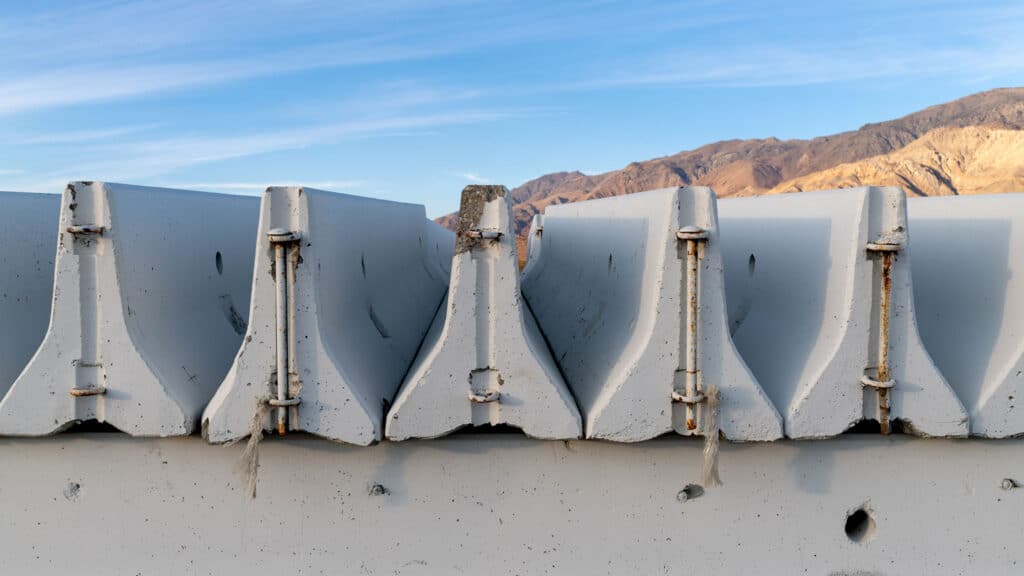Concrete barriers are a staple in our everyday lives that you probably take for granted. You see concrete barriers the most in construction zones, pedestrian walkways, trafficked roads, and near heavy machinery. However, people are beginning to use concrete barriers in more creative ways, including security barriers, fences, skate parks, urban landscaping, benches, and other features. Whichever way these simple engineering features are used, they are significant building blocks of everyday society.
Let’s break down what concrete barriers are all about, so you can decide what styles work best for your project.
Although concrete barriers serve an important purpose by separating walkways and oncoming traffic from the road, they also have several other equally important applications.
These barriers are used to protect utilities and materials. Concrete barriers can effectively block sensitive wiring and underground materials from being hit by heavy machinery and forms on the job site.
They can also be used to deter traffic, separate materials, and prevent erosion in certain areas. Because concrete traffic barriers must be durable, the most effective fabrication methods must be used to build them.
To find the best concrete barrier for your project, you must consider the different styles. At Harper Precast, you can choose between two options and customizable services, including constant-slope and Jersey barriers.

A general concrete barrier is also known as a constant slope barrier. These single-slope barriers came to be when industries saw the need for a concrete barrier with consistent performance.
Both constant-slope barriers and vertical concrete walls can facilitate resurfacing because their performance is insensitive to the thickness of the asphalt overlay. This is particularly advantageous when constructing barriers on curved ramps and for resurfacing operations that otherwise would require resetting concrete safety shape barriers.
The constant-slope barrier ranges in size, including standard 15’, transition 10’, and a terminal end of 20’. You can also customize your length depending on your project with personalization options.

A concrete jersey barrier is a portable concrete barrier that separates lanes of traffic. These specifically designed barriers help minimize vehicle damage in cases when cars hit incidentally. Instead, the wall redirects the vehicles into further head-on collisions.
Jersey barriers can also be set up to reroute traffic and protect pedestrians during highway construction. The main advantage of using these rather than other concrete barrier types is that they are modular and easier to move. It’s well-known among the transportation industries that Jersey barriers or K-rails are temporary concrete traffic barriers.
It was first made in the 1950s in New Jersey. Since its inception, the barrier has gotten stronger with steel reinforcements inside of the concrete. Now, Jersey barriers typically stand at 32 inches tall. However, you can work with a concrete specialist to customize the shape and size of your Jersey barrier.

Another option that is gaining in popularity is the F-shape concrete barrier. The F-shape barrier is a modified version of the Jersey barrier. The F-shape is a new generation of concrete barrier blocks intended to limit vehicle damage further and increase safety among drivers.
The face of the barrier features a lower slope that redirects vehicles under low-impact conditions. During moderate to severe impacts, some energy is dissipated when the car is lifted off the pavement. The F-shape reduces this lift, which promotes better vehicle stability while maintaining vehicle redirection.
Since these concrete barrier blocks are newer to the industry than most other shapes, you can rely on your concrete specialist to determine if it is the right choice for your project.
Now that you know a little bit about concrete barriers let’s look at a few other interesting facts.
Concrete barriers are the common name given to highway barriers used for traffic control and perimeter protection.
Jersey barriers appear to be simple, but they are highly sophisticated. The design of these concrete barrier blocks was tweaked for decades to ensure optimal driver safety.
The origin of the name “jersey barriers” stems from the late 1940s when many US States created their design of concrete barriers. In 1949, the state of New Jersey came up with the most conducive concrete structures that were highly successful in lowering the impact of collisions. Now those structures are known as Jersey barriers, K-rails, or Jersey bumps.
Traffic barriers can be made of plastic or concrete. However, concrete is the most popular choice because of its durability. The design of concrete barriers incorporates a strong interlocking system that appends together, forming an insuperable barrier.
Concrete barrier blocks are commonly used in construction sites. Apart from offering protection, the barriers also help absorb noise. Workers will set up concrete barriers throughout a construction site to help minimize noise and increase safety.
Harper Precast is one of the leading concrete barrier manufacturers in Utah and the Intermountain West. Working with our experts, you can discover the concrete barrier design that will fit your needs.
Whichever barrier you choose, our team will work with you to determine the exact specifications of each structure by considering the location of the project, traffic expectations, and other project requirements. Harper Precast also offers customized concrete barrier block designs, so you will always have the options you deserve working with our team.
Get in touch with Harper Precast to get started.